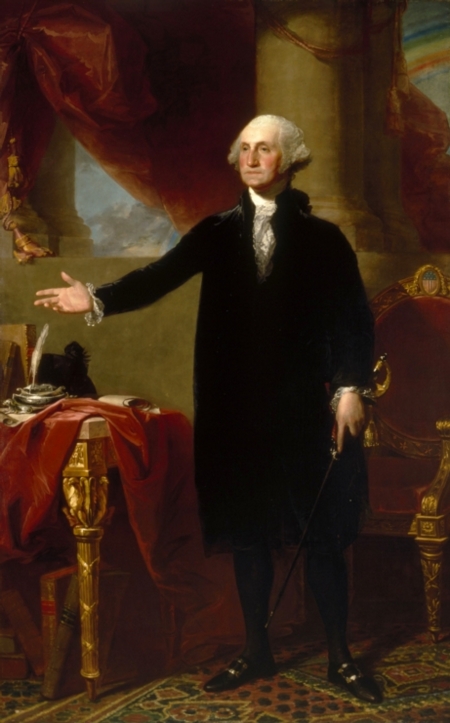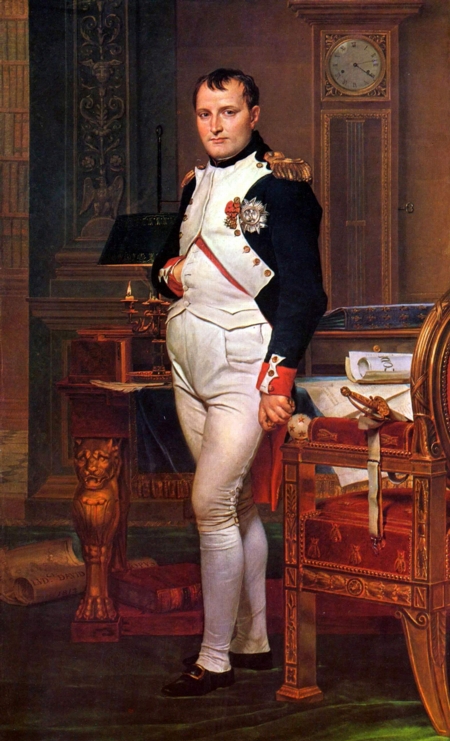
Images of Liberty and Power
[Created November 12, 2010]
[Updated June 12, 2011]
[Updated June 12, 2011]
 |
 |
Gilbert Stuart, George Washington (1796) (“the Lansdowne Portrait”) |
Jacques-Louis David, The Emperor Napoleon
in His Study at the Tuileries (1812) |
| Observations on republican & imperial leaders
in their studies: There are some striking parallels in the
lives of George Washington and Napoléon Bonaparte: both were military
leaders who helped their countries during a revolution and both came
to power as head of a republic which had shaken off the shackles of
monarchy. But whereas Washington was content to return to civilian
life and promote the development of the new republican institutions
of the U.S., Napoleon sought to centralise power in his own hands as
First Consul and then as a self-crowned Emperor of the French. The
former remained a staunch republican whilst the latter turned into
a tyrant. Washington in his "Farewell Address" of 1796 warned
of the dangers to the new republic of trying to behave like a traditional
European power with "entangling alliances" which would suck
it into wars and international conflicts. Napoleon on the other hand
sought to use military force to "free" Europe from "feudalism" from
Spain in the west to Russia in the east. I think by the time the portrait
on the right was painted (some 8 years after the events depicted in
the painting took place) Napoleon sensed that his imperial ambitions
might lead to naught and that his most enduring legacy would the legal
reform he introduced with the Civil Code. The painting on the left shows Washington as a “working President” who has been writing a report or proposal of some kind requiring considerable research. The most important thing Washington wrote in 1796, on which he might have been working in the painting, is his “Farewell Address” which was published in September. It has been suggested that the 2 books on the table might be a copy of The Federalist and the Journal of Congress although this is hard to tell from the image. His simple attire is in keeping with enlightened notions of simplicity, frugality, and an avoidance of old regime regal luxury. There are 2 references to Roman traditions with the table leg fasces (a symbol of republican strength where multiple wooden rods are tied into an unbreakable bunch) and the Roman-style columns. Roman models were chosen for American political bodies such as the Senate, the Capitol building, and for the architectural design of many other public buildings. The rainbow in the background is an allegory that suggests that the political and military storm which had wracked the new republic during its war with great Britain was now over and that a “new era” of freedom was dawning. Napoleon was First Consul of France (1799-1804) and then Emperor (1804-1815). In this painting he is shown as very much a “working emperor” having stayed up all night working on his reform of the French legal system (the “Napoleonic” or Civil Code which was promulgated in 1804). He has been consulting large legal books and possibly annotating the drafts of the code written by expert lawyers. He is dressed as a simple solider, avoiding the monarchical symbols and attire he wore in other paintings at the time of his coronation as Emperor in 1804 (compare François Gerard, Napoleon in his Coronation Robes (1804)). Nevertheless, there is an understated theme of militarism and imperialism with the imperial eagle, the Roman fasces, the Egyptian lion, the copy of Plutarch’s Parallel Lives, and his simple military uniform and single medal. It seems that in 1812 (when this painting was painted), close to his defeat in Russia and the ultimate end of his Empire, Napoleon wanted to return to an earlier period and to depict himself as an enlightened reformer working on one of his greatest legacies to the French nation. |
|